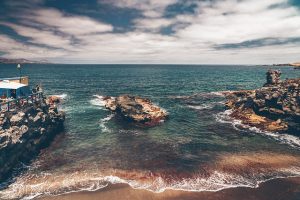The evidence of contacts with the civilizations of classical antiquity – especially with the Roman Empire, but sometimes also with other cultures of that time – has been based on alleged isolated archaeological finds at sites in America originating in the Old World.
 The stable presence of the Romans and Phoenicians, probably in the Canary Islands, has led some researchers to suggest that the islands could have been used as a starting point to intensify these trips, as the islands are located along the same favorable maritime route arranged by Columbus on his first trip to the Americas. According to the writer and philosopher Roman of the first century Pliny the Elder, the archipelago was uninhabited when it was visited by the Carthaginians Hanno the Navigator, and did not see ruins of great buildings. This story may suggest that other peoples inhabited the islands prior to the Numidian king Juba, a Roman protégé of Augustus who is credited with discovering the islands to the western world. He sent a naval contingent to reopen the dye production plant at Mogador in western Morocco in the early 1st century AD. That same naval force was later dispatched on an exploration of the Canary Islands, with Mogador as the mission base. Essaouira (Mogador) has long been considered one of the best anchorage places on the Moroccan coast. The Carthaginian navigator Hanno visited and established a garrison there in the 5th century BC.
The stable presence of the Romans and Phoenicians, probably in the Canary Islands, has led some researchers to suggest that the islands could have been used as a starting point to intensify these trips, as the islands are located along the same favorable maritime route arranged by Columbus on his first trip to the Americas. According to the writer and philosopher Roman of the first century Pliny the Elder, the archipelago was uninhabited when it was visited by the Carthaginians Hanno the Navigator, and did not see ruins of great buildings. This story may suggest that other peoples inhabited the islands prior to the Numidian king Juba, a Roman protégé of Augustus who is credited with discovering the islands to the western world. He sent a naval contingent to reopen the dye production plant at Mogador in western Morocco in the early 1st century AD. That same naval force was later dispatched on an exploration of the Canary Islands, with Mogador as the mission base. Essaouira (Mogador) has long been considered one of the best anchorage places on the Moroccan coast. The Carthaginian navigator Hanno visited and established a garrison there in the 5th century BC.
Head of Tecaxic-Calixtlahuaca
A small Roman terracotta head, showing a beard and a number of European features, was found in 1933 (in the Toluca Valley, 72 kilometers southwest of Mexico City) in an intact three-story ceremonial burial of a pre-colonial building. The stylistic examination confirms that it is a Roman work from around the second century AD, and the style of its hair cut and hairstyle is classic of the emperors of the Severian period [193-235 AD], exactly in the ‘appearance’ of the time.
Artistic inscriptions
Contact claims have often been based on the occurrence of similar motifs in art and decoration, or on representations in a cultural setting, of species or objects believed to be characteristic of the other culture. Famous examples are a Mayan statuette depicting a bearded man with oars and a bas-relief cross in the Temple of the Cross at Palenque or depicting a pineapple in a mosaic on the wall of a house in Pompeii. However, most of these findings can be explained as a result of misinterpretation. The “Cross” of Palenque, for example, is almost certainly a stylized corn plant, and the “pineapple” of Pompeii is more likely a pine cone.
Bat Creek Inscription
The dubious Bat Creek and Stone inscription of the Decalogue of the Moons have led some to suggest the possibility that Jewish seafarers may have arrived in America after fleeing the Roman Empire at the time of the Jewish Revolt.
Magna Fountain
The Fountain Magna ‘, also known as the Fountain Bowl, is a large stone vase, resembling a libation vessel. It is claimed to have been found in the 1950s by a worker at Hacienda Chua near Tiwanaku, west of La Paz, Bolivia. The inscription has been claimed to contain Sumerian writings and is said to resemble those later on the Pokotia monolith.
Olmec
An African presence in Mesoamerica has been proposed based on the Olmec culture’s attributes, the presence of a species of African plant in the Americas, and the interpretation of certain European and Arab historical accounts.
The Olmec culture existed from approximately 1200 BC to 400 BC. The idea that the Olmecs are related to the Africans was suggested by José Melgar, who discovered the first colossal head in Hueyapan in 1862 and later published two documents attributed this head to a “black race.”Authors such as Ivan van Sertima proposed that these heads represented settlers or explorers from Africa.




